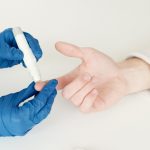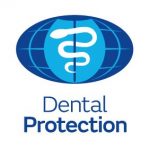It is predicted one in seven Britons are suffering from diabetes mellitus and one in three have incipient and undiagnosed pre-diabetes. This will be a major problem for our medical colleagues and us. We should be very involved with these patients.
There are two main groups of diabetics:
Type I: There is an absolute deficiency of insulin. Patients are usually in a younger age group.
Type II: Is characterised with both insulin resistance and a deficiency. It is usually found in older age groups and is associated with obesity.
As well as Gestational Diabetes, during pregnancy and other, associated with other diseases, drug use or genetics for Indian and African peoples.
Traditionally diabetes has been diagnosed following a fasting blood glucose or a glucose tolerance test. A simpler test measures HbA1C, counting the number of glucose molecules attached to red blood cells. If this is above 6.5 mmol/L, it is officially diabetes. The target of treatment is to maintain this glycolysated haemoglobin at below 6.5 per cent as this has been shown to lead to fewer diabetic complications (1).
Diabetics have serious complications including:
- Retinopathy leading to blindness
- Cardiopathy
- Nephropathy
- Neuropathy
- Micro and macro arterial disease
- The sixth, dental complications, have received much less publicity (2). They are periodontopathy , and xerostomia. Other dental symptoms, caused by neurological changes, include burning mouth and tongue and altered taste sensations
It is not just the diagnosis of hyperglycaemia that is important but its severity that affects the periodontium most (3,4). Diabetics have a 3 – 4 times greater risk of developing periodontal disease than non-diabetics (5); for diabetic smokers the risk significantly greater (6).
We define periodontal disease as the loss of bony support to the teeth, increased pocket depth and inflammation of the surrounding tissues caused by the body’s reaction to plaque (7), whilst xerostomia is reduced salivary output with its risk of developing caries (4). High blood glucose levels are also associated with an increased incidence of oral thrush.
Periodontal disease is a reaction to toxins produced by dental plaque and an abnormal immune response with reduced levels of tissue healing, the severity and progression of which depend on the host response to biofilm, although the causative organisms are still under debate (8).
Diabetic periodontopathy was first recognised by Williams in 1928 (9). Recent research has shown as close inter-relation between diabetes and periodontitis, the one affecting the other and vice versa, a two-way street between these diseases (10,11). Diabetes and periodontal disease are biologically linked (12,13).
- This interrelationship between diabetes and periodontal disease provides an example of systemic diseases predisposing to oral ‘infection’, and once that ‘infection’ is established there is an exacerbation of systemic disease (17)
- Diabetics and non-diabetics have a similar oral flora (14)
- Diabetics have an increased susceptibility to infection and delayed wound healing (15)
- There is a common pathogenesis between diabetes and periodontal disease involving an enhanced inflammatory response at both local and systemic level. This is caused by the chronic effects of hyperglycaemia and formation of advanced glycation end-products and lipids that promote the inflammatory response (15,16)
- Diabetics have significantly higher levels of local inflammatory mediators, especially cytokines and tissue necrosis factor when compared with systemically healthy people with periodontal disease (15,18). Interleukin 8 is also raised and give a potential contribution to cross-susceptibility (19)
- Diabetes enhances periodontal bone loss through enhanced resorption and diminished bone formation(20)
- The severity of periodontal disease in diabetics may not correspond to levels of bacterial plaque observed clinically. More aggressive treatments may be required (21)
- C-reactive protein levels are raised in both diabetes and periodontal disease (14)
- Antibiotics prescribed for periodontal disease may reduce insulin requirements (21). However,there is no consistent evidence that the addition of antimicrobials to scaling and root planning is of benefit (22)
- Periodontitis progression is associated with an increase in HbA1c levels in type 2 diabetes (23)
- Periodontitis may play a role in increasing the incidence of new cases of type 2 diabetes and possibly gestational diabetes (24)
- There is a significant association of periodontal disease with gestational diabetes mellitus and pre-eclampsia (25)
Various mechanisms for this altered immune response in the periodontal tissues of diabetics have been suggested, but none are proven. However, polysaccharides in Gram negative bacteria stimulate the production of cytokines and oxidative stress is critical in the development of diabetic complications (8).
As periodontal disease and diabetes mellitus affect each other, there is some early evidence to suggest that individuals with periodontal disease may be at higher risk of developing Type II diabetes (16) and pre-eclampsia (25). Periodontal infection has an adverse, yet modifiable effect on glycaemic control (26). When periodontal disease is brought under control and pathogens removed, the HbA1C level falls (16), there is improved glycaemic control (23) and there can be a reduced requirement for insulin dosage. The overall management of diabetes may improve (27) because. periodontal therapy improves metabolic control (23).
The emphasis must be for individuals to improve their personal plaque control, to reduce the numbers of bacteria and biofilm both supra- and sub-gingivally using toothbrushes and interspace brushes.
These patients will also require frequent professional interactions, in depth oral health teaching, and consistent educational reinforcement.
This means that all diabetic patients should be advised that they are at increased risk of developing periodontal disease and need regular dental care because of the positive bidirectional association between periodontal disease and diabetes mellitus and underlines the need for screening of patients with periodontal disease for diabetes mellitus and vice versa (28). However, this is not happening because this recommendation does not appear on the annual NICE check list for General Medical Practitioners and very few doctors have been taught about this inter-relation.
The evidence is overwhelming that the alveolar bone loss associated with periodontal disease is the result of a complex inflammatory response to plaque antigens. It follows that, if individual patients can be educated and persuaded to fully control their plaque on a daily basis, then the inflammatory reaction will subside. This requires dental appointments and skilled teaching in toothbrushing techniques, interdental plaque control, the relationship of the Stephan pH curve to the development of caries, and follow-up.
Diabetics have to learn to manage their blood sugar levels following suitable education and guidance. Therefore, the vast majority are capable of managing and controlling their plaque. However, doctors are not checking that diabetic patients are receiving dental care.
There is an unmet need for in-depth guidance from Public and Professional Bodies. This is made more complicated because health care in the UK is devolved to the Welsh and Northern Irish Assemblies, the Scottish Parliament as well as the Westminster Government for England. The main general educational focus is theirs. Each may develop its own system but all need to take action. They could begin with a simple poster campaign placed in every hospital diabetic clinic, GP practice and pharmacy to advise diabetics to seek regular dental care because the evidence is unequivocal, diabetes and periodontal disease are interrelated.
For example, the charity Diabetes Now website does mention periodontal disease as a complication of diabetes without explaining in detail what it is or what the consequences can be (29).
Two years ago I asked NICE to add dental care to the General Medical Practitioners check list. Despite providing evidence they refused. I shall try again.
There is an absence of inter-professional collaboration between doctors and dentists while managing patients with diabetes mellitus (30). However, there is action we as dentists could take now to educate our medical colleagues:
Notify the GP of each diabetic patient you are caring for and ask for the HbA1C blood test results. Provide details of your ongoing BPE scores with an explanation of the numbers in return and show how periodontal disease is progressing or regressing.
If you have a patient with developing periodontal disease that has an atypical pattern or does not resolve, or xerostomia, burning mouth or sensory loss you must consider diabetes or prediabetes as a contributing factor and refer your patient to his/her GP for blood sugar investigations, especially Hba1C levels.
Share you BPE scores with your patients and explain what the numbers mean. If you need full 6 point pocket depth measurements with a bleeding index, record of gingival recession or an interproximal brush use chart share them too.
Consider the timing of repeat radiographs to avoid unnecessary radiation. This will have to be determined by clinical presentation and the rapidity or otherwise of periodontal deterioration. For apparently well controlled cases, perhaps further radiographs at 3 yearly intervals are indicated (7).
If doctors refer new diabetic patients, stage one of treatment is to remove supra and subgingival calculus and biofilm, the latter of which can only be removed by ultrasonic scaling, teaching OHI and interproximal plaque control.
In the first instance recalls are likely to be at three monthly intervals. Depending on patient response, this interval may be increased. The classic signs of periodontal improvement are:
- Reduction in the number of bleeding points
- Reduction in pocket depth
- Reduction in plaque score
- No further bone loss radiographically
Another sign of periodontal improvement is:
- Increase in interspace brush diameter in some interproximal spaces with time (30)
The bottom line is clear; patients need to control their plaque effectively and efficiently to control periodontal disease, caries and reduce the effects of systemic diseases. Whilst daily plaque control must remain their responsibility as dentists our responsibility is to show patients how to control their plaque effectively and to monitor and record progress (or regress) at regular intervals.
In summary there is a need for:
- Doctors and dentists to work together and share test results
- An education campaign to encourage diabetics to attend for dental care
- Better dental record keeping and sharing this information with patients
- Develop better ways to help patients control their plaque on a daily basis
- Publicity at national and local level about the two-way relationship between diabetes and dental disease
About the Author

Dr Turner was a Specialist in Restorative Dentistry before his retirement from clinical practice. His achievements include inventing colour coded pocket probes, setting up the Dental Practice Unit at Sheffield Dental School in 1080 and its first Head, moving to Salisbury as Director of Dental Services and Postgraduate Tutor then specialist referral practice from 199.
He developed the Spacemark Dental interdental brushing chart to assist patients in achieving ideal daily plaque and periodontal disease control.
References:
- National Diabetic Information Clearinghouse (NDIC) website (US).
- Löe H.
Periodontal disease. The sixth complication of diabetes mellitus.
Diabetes Care 16: 329, 1999.
- Genko RJ, Borgnakke WS
Risk factors for periodontal disease
Periodontol 2000 62: 59, 2013.
- Kocher T et al
Periodontal complications of hyperglycaemia/diabetes: Epidemiological complexity and clinical challenge.
Periodontol 2000 78: 59, 2018.
- Preshaw PM, Bissett SM.
Periodontitis: oral complications of diabetes.
Endocrinol Metab Clin North Amer 42: 849, 2013.
- Battancs E etal
Periodontal Disease in Diabetes Mellitus: A Case-Control study in Smokers and Non-Smokers.
Diabetes Ther 11: 2715, 2020.
- American Academy of Periodontology website.
- Wu YY, Xioa E, Graves T.
Diabetes Mellitus related bone metabolism and periodontal disease.
Int J Oral Sci 7: 63, 2015.
- Williams J.
Diabetic periodontoclasia.
J Amer Dent Assoc 15: 523, 1928.
- Preshaw B et al.
Periodontitis and diabetes – a two way relationship
Diabetologia 55: 21, 2012.
- Mealy BL.
Periodontal disease and diabetes – a two way street.
J Amer Dent Assoc 137: 265,2006.
- Bullon P, Newman HN, Battino M.
Obesity, atherosclerosis and chronic periodontitis: a shared pathway via oxidative stress and mitochondrial dysfunction?
Periodont 2000 64: 139, 2014.
- Tsaic C, Hayes C, Taylow GW.
Glycaemic control of type II diabetes and severe periodontal disease in the US adult population.
Community Dent Oral Epidemiol 30: 182, 2002.
- Moore PA et al.
Type I diabetes mellitus and oral health.
J Periodont 70: 409, 1999.
- Liu R et al.
Tumor necrosis factor-alpha mediates diabetes-enhanced apoptosis of matrix-producing cells and impairs diabetic healing.
Am J Pathol 175: 1574, 2009.
- Wang TF et al.
Effects of periodontal therapy on the metabolic control in patients with type 2 diabetes and periodontal disease: a meta-analysis.
Medicine (Baltimore) 28: 292, 2014.
- Southerland JH et al.
Diabetes and periodontal infection – making he connection.
Clinical Diabetes 23: 171, 2009.
- Johnson DR et al.
Cytokines in type II diabetes.
Vitam Horm 74: 405, 2006.
- Lappin DF et al
The influence of glycated haemoglobin on the cross-susceptibility between type 1 diabetes and periodontal disease.
Periodont 86: 1249, 2015.
- Pucher J, Stewart J.
Periodontal disease and diabetes mellitus.
Curr Diab Rep 4: 46, 2004.
- Grossi SG, Genco RJ.
Periodontal disease and diabetes mellitus; a two way relationship.
Ann Periodontal 3: 51, 1998.
- Simpson TC et al.
Cochrane Database Syst rev, CD004714, 2015.
- Costa Kl et al.
Influence of periodontal disease on changes of glycated haemoglobin levels in pateints with type 2 diabetes mellitus: a retrospective cohort study.
J Periodontol 88: 17, 2017.
- Genco RJ, Graziani F, Hasturk H.
Effects of periodontal disease on glycaemic control, complications and incidence of diabetes mellitus.
Periodont 2000 83: 59, 2020.
- Kumar A et al.
Association between periodontal disease and gestational diabetes mellitus: A prospective cohort study.
J Clin Periodont 45: 920, 2018.
- Taylor GW.
Bidirectional inter-relationship between diabetes and periodontal disease: an epidemiological perspective.
Ann Periodontol 1: 99, 2001.
- Mealy BL, Rethman MP.
Periodontal disease and diabetes mellitus. Bidirectional relationship.
Dent Today 22: 107, 2003.
- Diabetes Now website.
- Stöhr J.
Biderectional association between periodontal disease and diabetes mellitus: a systematic review and meta-analysis of cohort studies.
Sci Rep 11: 136, 2021.
- Siddiqi J et al.
Diabetes mellitus and periodontal disease: The call for interprofessional education and inter-professional collaborative care.
J Interprof care 10: 1, 2020.
- Turner CH.
Implant maintenance
The Dentist pp62, 2011.
















